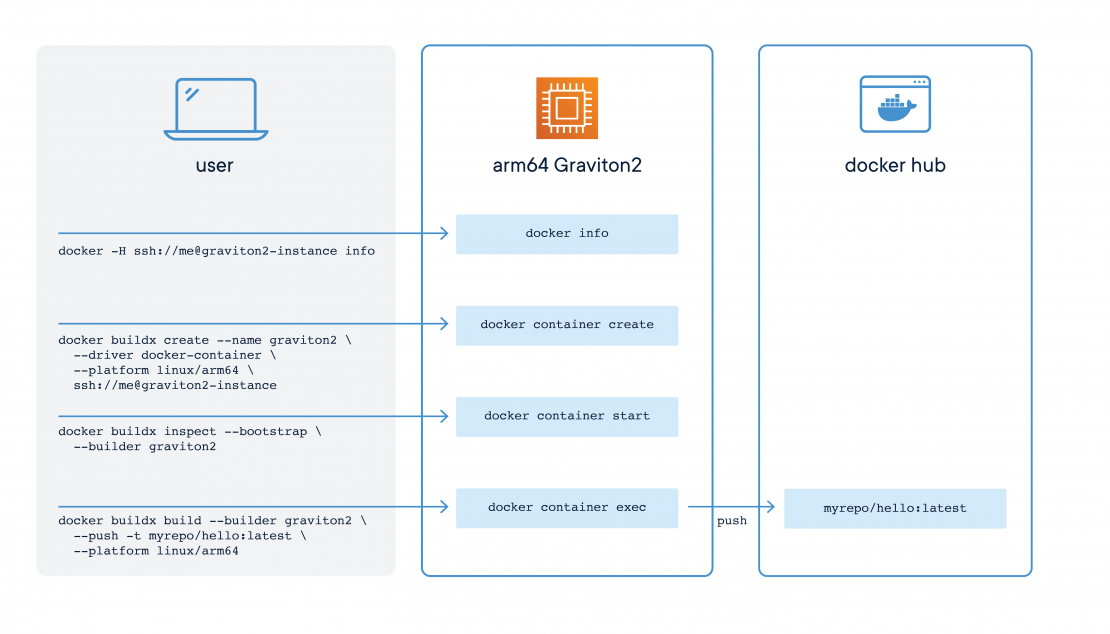As the expansion in Arm usage continues, building your images on Arm is crucial to making images available and performant across all architectures which is why we’ve invested in making it super easy to build Arm and multi-arch images. In a previous blog we outlined how to build multi-arch images locally using the QEMU emulator that comes pre-packaged with Docker Desktop. In this blog we outline how to get started using a remote builder to accomplish the same goal, for our purposes we will be using an Amazon EC2 instance. In December of 2019, Amazon announced the new Amazon EC2 instances powered by AWS Graviton2 Processors that significantly improve performance over the first-generation AWS Graviton processors. Using a Graviton2 instance to build your Arm images remotely will speed up the process, making it even easier to develop containers on, and for, Arm servers and devices.
We will walk through the following:
- Using Graviton2 EC2 instance as a remote host
- Registering the Graviton2 EC2 instance as remote builder
- Building the docker image on Graviton2 EC2 instance
To learn more about buildX and remote builders, you can visit our documentation.

Getting Started With a Remote Builder
Prerequisites
First we’ll have to ensure that you are using a remote host instead of your local machine. Common ways to access remote Docker instances are via mTLS or SSH. Here we will use SSH for simplicity. In order to start with using a remote builder with Buildx and BuildKit on Graviton2 the host needs to be accessible through the Docker CLI, using ssh://<USERNAME>@<HOST> URL as follows:
$ docker -H ssh://me@graviton2-instance info
Client:
Context: default
Debug Mode: false
Plugins:
buildx: Build with BuildKit (Docker Inc., v0.6.1-65-gad9dddc3)
compose: Docker Compose (Docker Inc., v2.0.0-rc.3)
scan: Docker Scan (Docker Inc., v0.8.0)
Server:
Containers: 0
Running: 0
Paused: 0
Stopped: 0
Images: 0
Server Version: 20.10.9
Storage Driver: overlay2
Backing Filesystem: extfs
Supports d_type: true
Native Overlay Diff: true
userxattr: false
Logging Driver: json-file
Cgroup Driver: cgroupfs
Cgroup Version: 1
Plugins:
Volume: local
Network: bridge host ipvlan macvlan null overlay
Log: awslogs fluentd gcplogs gelf journald json-file local logentries splunk syslog
Swarm: inactive
Runtimes: io.containerd.runc.v2 io.containerd.runtime.v1.linux runc
Default Runtime: runc
Init Binary: docker-init
containerd version: 5b46e404f6b9f661a205e28d59c982d3634148f8
runc version: v1.0.2-0-g52b36a2
init version: de40ad0
Security Options:
apparmor
seccomp
Profile: default
Kernel Version: 5.4.0-1045-aws
Operating System: Ubuntu 20.04.2 LTS
OSType: linux
Architecture: aarch64
CPUs: 2
Total Memory: 1.837GiB
Create the remote builder with Buildx
Now you can register this remote Graviton2 instance to Docker Buildx using the create command:
$ docker buildx create --name graviton2 \
--driver docker-container \
--platform linux/arm64 \
ssh://me@graviton2-instance
graviton2--platform is specified so that this node will be preferred for arm64 builds when we add other nodes to this build cluster.
Bootstrap the builder to check and create the BuildKit container on the remote host:
$ docker buildx inspect --bootstrap --builder graviton2
#1 [internal] booting buildkit
#1 pulling image moby/buildkit:buildx-stable-1
#1 pulling image moby/buildkit:buildx-stable-1 2.2s done
#1 creating container buildx_buildkit_node1
#1 creating container buildx_buildkit_node1 1.4s done
#1 DONE 3.7s
Name: graviton2
Driver: docker-container
Nodes:
Name: node1
Endpoint: ssh://me@graviton2-instance
Status: running
Platforms: linux/arm64*, linux/arm/v7, linux/arm/v6Build your image
Now we will create a simple Dockerfile:
FROM busybox as build
ARG TARGETPLATFORM
ARG BUILDPLATFORM
RUN echo "I am running on \$BUILDPLATFORM, building for \$TARGETPLATFORM" > /log
FROM busybox
COPY --from=build /log /log
RUN cat /log
RUN uname -a
And let’s build the image against our builder:
docker buildx build --builder graviton2 \
--push -t example.com/hello:latest \
--platform linux/arm64 .
#2 [internal] load .dockerignore
#2 transferring context:
#2 transferring context: 2B 0.2s done
#2 DONE 0.2s
#1 [internal] load build definition from Dockerfile
#1 transferring dockerfile: 246B 0.3s done
#1 DONE 0.4s
#3 [internal] load metadata for docker.io/library/busybox:latest
#3 ...
#4 [auth] library/busybox:pull token for registry-1.docker.io
#4 DONE 0.0s
#3 [internal] load metadata for docker.io/library/busybox:latest
#3 DONE 1.5s
#5 [build 1/2] FROM docker.io/library/busybox@sha256:f7ca5a32c10d51aeda3b4d01c61c6061f497893d7f6628b92f822f7117182a57
#5 resolve docker.io/library/busybox@sha256:f7ca5a32c10d51aeda3b4d01c61c6061f497893d7f6628b92f822f7117182a57 0.0s done
#5 DONE 0.0s
#5 [build 1/2] FROM docker.io/library/busybox@sha256:f7ca5a32c10d51aeda3b4d01c61c6061f497893d7f6628b92f822f7117182a57
#5 sha256:7560ee4921c3fab4f1d34c83600f6f65841ec863e072374f4e8044ff01df156f 821.72kB / 821.72kB 0.1s done
#5 extracting sha256:7560ee4921c3fab4f1d34c83600f6f65841ec863e072374f4e8044ff01df156f 0.0s done
#5 DONE 0.2s
#6 [build 2/2] RUN echo "I am running on $BUILDPLATFORM, building for $TARGETPLATFORM" > /log
#6 DONE 0.1s
#7 [stage-1 2/4] COPY --from=build /log /log
#7 DONE 0.0s
#8 [stage-1 3/4] RUN cat /log
#8 0.078 I am running on $BUILDPLATFORM, building for $TARGETPLATFORM
#8 DONE 0.1s
#9 [stage-1 4/4] RUN uname -a
#9 0.081 Linux buildkitsandbox 5.4.0-1045-aws #47-Ubuntu SMP Tue Apr 13 07:04:23 UTC 2021 aarch64 GNU/Linux
#9 DONE 0.1s
#10 exporting to image
#10 exporting layers
#10 exporting layers 0.3s done
#10 exporting manifest sha256:7097ec1c09675617e2c44b5924b76f7863c4ff685c640b32dfaa1b1e8f2bc641 0.0s done
#10 exporting config sha256:d18ca92a45b563373606f0a06d0a1d2280d0c11976b1ca64dba0e567d540a3e2 0.0s done
#10 pushing layers
#10 pushing layers 0.7s doneNow, you’ve built your image remotely using a Graviton2 instance! These are just some of the things you can do with buildx. We’d love your feedback on how it went and what you’d like to see us do next, you can submit it feedback to our public roadmap.






